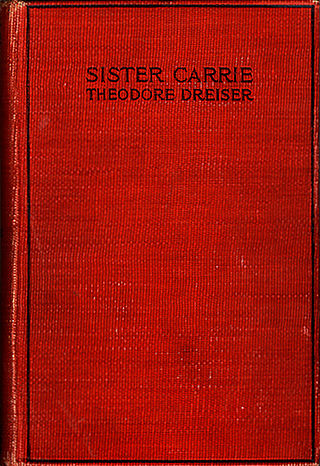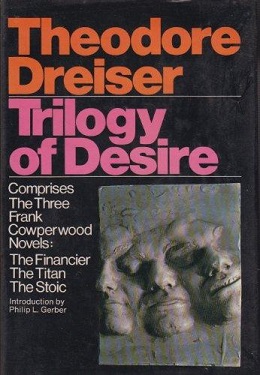
Charles Tyson Yerkes Jr. was an American financier. He played a part in developing mass-transit systems in Chicago and London.

Theodore Herman Albert Dreiser was an American novelist and journalist of the naturalist school. His novels often featured main characters who succeeded at their objectives despite a lack of a firm moral code, and literary situations that more closely resemble studies of nature than tales of choice and agency. Dreiser's best known novels include Sister Carrie (1900) and An American Tragedy (1925).

Charles Hoy Fort was an American writer and researcher who specialized in anomalous phenomena. The terms "Fortean" and "Forteana" are sometimes used to characterize various such phenomena. Fort's books sold well and are still in print. His work continues to inspire admirers, who refer to themselves as "Forteans", and has influenced some aspects of science fiction.

Sister Carrie (1900) is a novel by Theodore Dreiser (1871–1945) about a young woman who moves to the big city where she starts realizing her own American Dream. She first becomes a mistress to men that she perceives as superior, but later becomes a famous actress. It has been called the "greatest of all American urban novels".

Burr: A Novel is a 1973 historical novel by Gore Vidal that challenges the traditional Founding Fathers iconography of United States history, by means of a narrative that includes a fictional memoir by Aaron Burr, in representing the people, politics, and events of the U.S. in the early 19th century. It was a finalist for the National Book Award in 1974.

Jean-Baptiste Antoine Marcelin Marbot, known as Marcellin Marbot, was a French general, famous for his memoirs depicting the Napoleonic age of warfare. He belongs to a family that has distinguished itself particularly in the career of arms, giving three generals to France in less than 50 years. His elder brother, Antoine Adolphe Marcelin Marbot, was also a military man of some note.
The Fortean Society was a New York City-based society started in the United States in 1931 during a meeting held in the flat of American writer Charles Hoy Fort, in order to promote his ideas of Forteana.

Charles Gilman Norris was an American novelist. A native of Chicago, Norris worked as a journalist for some years before finding success as a novelist and playwright. His first book was The Amateur (1916). His other novels include Salt (1919), Brass: A Novel of Marriage (1921), Bread (1923), Pig Iron (1926), Seed: A Novel of Birth Control (1930), Zest (1933), Hands (1935), and Flint (1944). He also published three plays: The Rout of the Philistines, A Gest of Robin Hood, and Ivanhoe: A Grove Play (1936).

The Titan is a novel by Theodore Dreiser, completed in 1914 as a sequel to his 1912 novel The Financier. Both books were originally a single manuscript, but the narrative's length required splitting it into two separate novels. Dreiser's manuscript of The Titan was rejected by Harper & Brothers, publisher of The Financier, due to its uncompromising realism; John Lane published the book in 1914. The Titan is the second part of Dreiser's Trilogy of Desire, a saga of ruthless businessman Frank Cowperwood. The third part of the trilogy, The Stoic, was Dreiser's final novel, published in 1947 after his death.

Three Act Tragedy is a work of detective fiction by British writer Agatha Christie, first published in the United States by Dodd, Mead and Company in 1934 under the title Murder in Three Acts and in the UK by the Collins Crime Club in January 1935 under Christie's original title. The US edition retailed at $2.00 and the UK edition at seven shillings and sixpence (7/6).

Robber baron is a term of social criticism originally applied to certain wealthy and powerful 19th-century American businessmen. The term appeared as early as the August 1870 issue of The Atlantic Monthly magazine. By the late 19th century, the term was typically applied to businessmen who used exploitative practices to amass their wealth. Those practices included unfettered consumption and destruction of natural resources, influencing high levels of government, wage slavery, squashing competition by acquiring their competitors to create monopolies and/or trusts that control the market, and schemes to sell stock at inflated prices to unsuspecting investors. The term combines the sense of criminal ("robber") and illegitimate aristocracy.

The Stoic is a novel by Theodore Dreiser, written in 1945 and first published in 1947. It is the conclusion of his Trilogy of Desire, which includes The Financier (1912) and The Titan (1914). This series of novels depicts Frank Cowperwood, a businessman based on the real-life streetcar tycoon Charles Yerkes. Dreiser had attempted to complete his trilogy in the early 1930s, but he was unable to begin The Stoic until near the end of his life; he died before he could finish the manuscript, and his widow Helen assembled the novel's final pages.
Tiffany Ellsworth Thayer was an American actor, writer, and one of the founding members of the Fortean Society.
The Logan Medal of the Arts was an arts prize initiated in 1907 and associated with the Art Institute of Chicago, the Frank G Logan family and the Society for Sanity in Art. From 1917 through 1940, 270 awards were given for contributions to American art.

Jennie Gerhardt is a 1911 novel by Theodore Dreiser.

The Bulwark is a 1946 (posthumous) novel by Theodore Dreiser.

The "Genius" is a semi-autobiographical novel by Theodore Dreiser, first published in 1915. The story concerns Eugene Witla, a talented painter of strong sexual desires who grapples with his commitment to his art and the force of his erotic needs. The book sold 8,000 copies in the months immediately following publication but encountered legal difficulties when it was declared potentially obscene. Dreiser's publisher was nervous about continuing publication and recalled the book from bookstores, and the novel did not receive broad distribution until 1923. When The "Genius" was reissued by a different publisher, the firm of Horace Liveright, it immediately sold more than 40,000 copies.

Loon Lake is a hamlet and a lake in the northeastern region of Adirondack Park in the U.S. state of New York. The community is located on the east side of Loon Lake and 18 miles (29 km) northeast of Saranac Lake and 27 miles (43 km) north of Lake Placid.

The Trilogy of Desire is a series of three novels by Theodore Dreiser:

Jennie Gerhardt is a 1933 American pre-Code drama film directed by Marion Gering for Paramount Pictures. It stars Sylvia Sidney, Mary Astor, and Edward Arnold. The film is based on the 1911 novel Jennie Gerhardt by Theodore Dreiser.
















